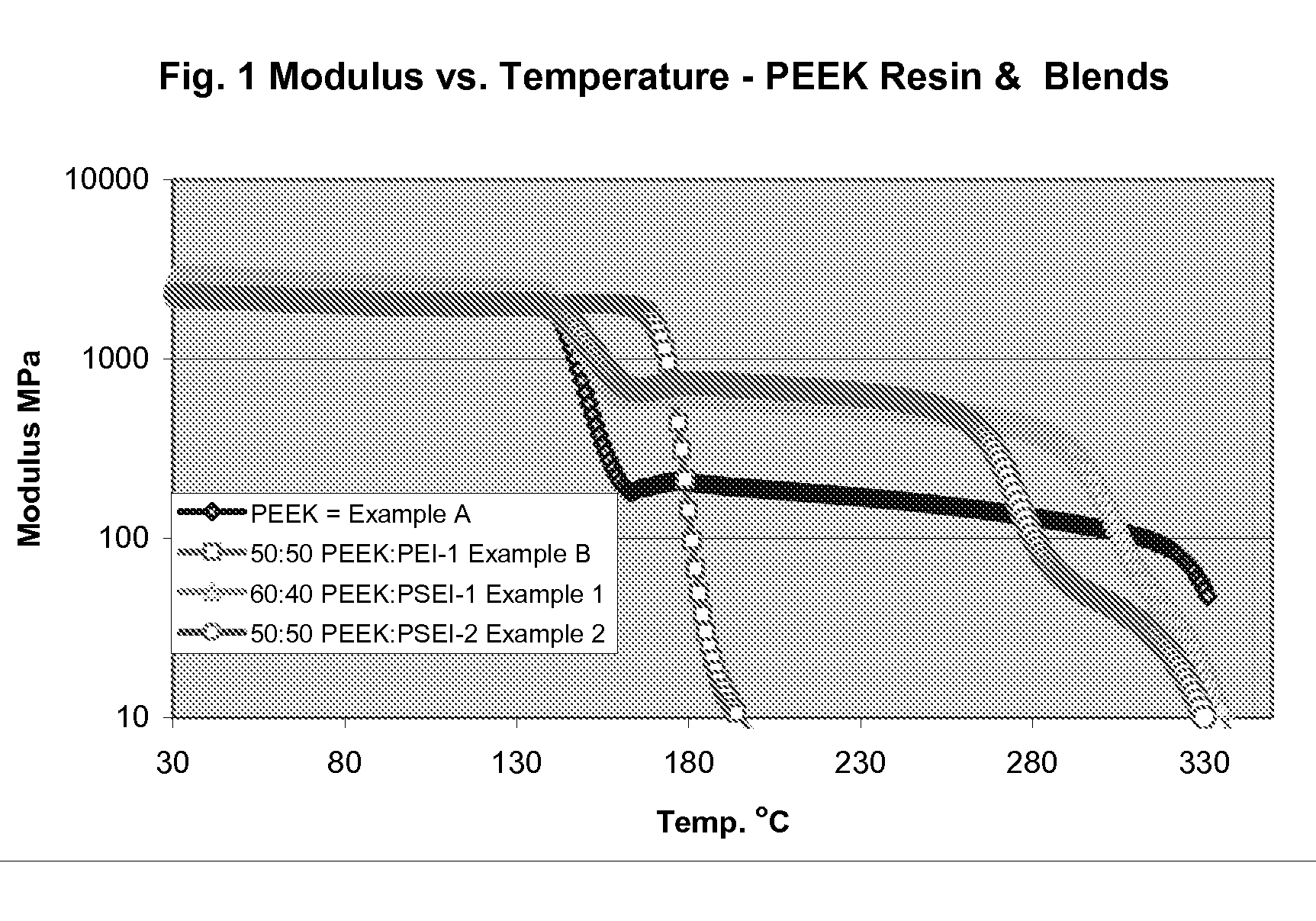Poly aryl ether ketone polymer blends
a technology of aryl ether and polymer blends, applied in the field of poly aryl ether ketone polymer blends, can solve the problems of limiting the use of reins at high temperatures under load, adversely affecting other properties, and increasing weigh
- Summary
- Abstract
- Description
- Claims
- Application Information
AI Technical Summary
Benefits of technology
Problems solved by technology
Method used
Image
Examples
examples
[0233] Blends are prepared by extrusion of mixtures of the polyaryl ether ketone, PEEK with polysulfone etherimides in a 30 mm twin-screw extruder. Compositions are listed in wt % of the total composition. The extruder was set at about 360 to 425° C. The blends are run at about 200 rpm under vacuum using mild mixing screws. The extrudate is cooled, pelletized and dried at 150-200° C. Test samples are injection molded at a set temperature of 370-430° C. and mold temperature of 120-200° C. using a 30-40 second cycle time.
[0234] Some properties are measured using ASTM test methods. All molded samples are conditioned for at least 48 h at 50% relative humidity prior to testing. Reverse notched Izod impact values are measured at room temperature on 3.2 mm thick bars as per ASTM D256. Heat distortion temperature (HDT) is measured at 0.46 MPa (66 psi) on 3.2 mm thick bars as per ASTM D648. Tensile properties are measured on 3.2 mm type I bars as per ASTM method D638. Flexural properties ar...
examples a
, B, 1 & 2
[0246] Table 1 shows blends of a crystalline PEEK resin with a polyetherimide (PEI) as well as two polysulfone etherimide (PSEI) resins. Example A shows the properties of the PEEK resin with no added ingredients, note the low HDT at 66 psi. Addition of a 50 wt % polyetherimide gives only a modest increase in the HDT. On the other hand example 1, which blends 40 wt % of a polysulfone etherimide made from reaction of ODPA with DDS (PSEI-1) increases HDT by 94° C. to 245° C. As shown other mechanical properties, for example modulus, strength and reversed Izod impact are increased compared to the appropriate control. A polysulfone etherimide copolymer containing linkages derived from a 80:20 mole % mixture of ODPA:BPADA polymerized with DDS (PSEI-2 resin, example 2) also shows a substantial increase in the 66 psi HDT by over 67° C., to 218° C.
TABLE 1ExamplesAB12PEEK Victrex 450 G100506050PEI-105000PSEI-100400PSEI-200050Vicat 50 N ° C.264169>270257HDT 66 psi ° C.151168245218T...
examples c & 3
[0249] Table 3 shows blends of PEEK containing 1 wt % of a crystallization agent, talc. Control example C using a PEI with no sulfone linkages, shows a relatively low 66 psi HDT of 169° C. even when the crystallization agent talc is added. The Vicat temperature of control example C is also relatively low at 177° C.
[0250] On the other hand, use of the polysulfone etherimide (PSEI-1) in the poly aryl ether ketone blend increases the 66 psi HDT and Vicat temperatures by almost 100° C. over control sample C.
TABLE 3ExamplesC3PEEK4949PEI-1500PSEI-1050Talc1.01.0Vicat 50 N ° C.177>270HDT 66 psi169262HDT 264 psi160161T. Str (Y) Mpa94.2103.5T. Mod Mpa34744269
[0251] The viscosity vs. shear rate and melt volume rate (MVR) for example 3 shown in table 4 was measured on a capillary rheometer at 380° C. with shear rates from 100 to 10,000 1 / sec. The PSEI-PEEK blend has a melt viscosity of from 2438 to 223 Pa-s. While this is higher than the control sample C, the PSEI viscosity still shows good ...
PUM
| Property | Measurement | Unit |
|---|---|---|
| wt % | aaaaa | aaaaa |
| wt % | aaaaa | aaaaa |
| wt. % | aaaaa | aaaaa |
Abstract
Description
Claims
Application Information
 Login to View More
Login to View More - R&D
- Intellectual Property
- Life Sciences
- Materials
- Tech Scout
- Unparalleled Data Quality
- Higher Quality Content
- 60% Fewer Hallucinations
Browse by: Latest US Patents, China's latest patents, Technical Efficacy Thesaurus, Application Domain, Technology Topic, Popular Technical Reports.
© 2025 PatSnap. All rights reserved.Legal|Privacy policy|Modern Slavery Act Transparency Statement|Sitemap|About US| Contact US: help@patsnap.com



